Electrofishing My Private 10 Acre Lake – (No Harm Came to Any Fish)
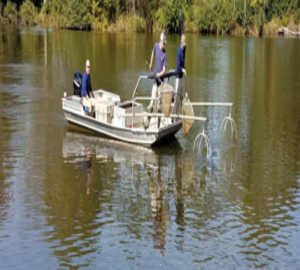
The day for electrofishing my 10 acre lake has finally come! The lake may be the most important aspect of my 40 acre property, and my favorite part of the land. The lake inhabits a variety of fish, along with an eclectic group of birds and reptiles.
Before I get into this interesting and exciting experience, I would like to take you back to the beginning, so you have a better idea on why I chose to electrofish my lake.
Ever since I’ve moved to this property, the lake has always been intriguing. Friends and I have tried fishing, but could never seem to catch anything! It was becoming frustrating, and a bit of a disappointment.
I knew that there were fish in the lake, I just couldn’t seem to reel them in to identify them. My good friend Trevor had a cast net, and thought it would be a good idea to try and net a few fish to get a better idea of what was swimming around. We purchased a small bass boat with a trolling motor so we could explore.
The First Time On Our Lake
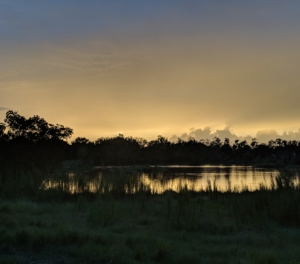
When we first hit the water in our new boat, we had two goals. First we needed to measure the depth of the lake, and second we needed to net some fish.
After trolling around and measuring multiple depths in various locations around the lake, we were in complete shock learning that our lake was way deeper than we thought. On average our lake was around 8 feet deep! In some locations it dropped to almost 14 feet! This was very encouraging, considering the fact that around the lake are perfect spawning areas for fish, with the marsh, cypress, and the floating clumps of grass for cover.
After learning that the lake was that deep, we decided it was time to net some fish. We used a small cast net in multiple locations around the lake, and all we seemed to pull up were Blue Gill and Golden Shiners. This wasn’t necessarily a bad thing, since Bass love Blue Gill and Shiners!
Even though we were excited about the bate fish being in the lake, we were still upset that we didn’t bring up Bass or any other type of fish for that matter.
This is when we decided to call Solitude Lake Management.
SOLitude Lake Management

SOLitude Lake Management is a company dedicated to providing services for any type of lake, and has branches in 22 states around the US.
With the pursuit of making the water in any lake more healthy, SOLitude offers pond and lake management strategies, fishery management, and lake mapping using GPS. They also offer quality testing of the water, bathymetric studies, and a wide variety of other services to keep your water preserved.
SOLitude has a few different specialties, but the thing that caught my eyes the most was the electrofishing.
I had never heard of electrofishing, and was very intrigued by what exactly this entailed. The only thing I knew was that I had a massive lake, and no idea what was living in it. Was electrofishing the answer?
What is Electrofishing?
Electrofishing is a process that uses direct current, transferring electricity between an anode and cathode under water.
This affects the movement of the fish within a 5 foot circle, drawing them in, and temporarily incapacitating them. This makes the fish easy to net.
There are a few different ways you can electrofish, but the easiest method for us was the stun boat.
How Does Electrofishing Work?
The electrofishing method relies on direct current being passed between two electrodes through the water. These are known as the anode and cathode. When the fish gets into a close proximity of the direct current, it is affected by the electricity.
Pulsations of direct current are applied which then causes a muscular convulsion in the fish, drawing it toward the anode. This convulsion is known as galvanotaxis. To run an effective stun boat you need two people. One person runs the pedal while steering the boat, and the other person stands at the bow to net the fish.
Why Would You Ever Use Electrofishing?
Electrofishing is most popularly used when managing a large body of water to gain information of the species swimming around.
When you electrofish a large body of water, there are many factors that can influence the effects, such as environmental, biological, logistical, and technical.
When using DC pulses for electrofishing, the size and nature of the catch is directly related to the currents pulse rate and intensity.
The conductivity of the water will influence the shape and field for the electricity. The better the conductivity of the water, the larger and more effective this tactic works.
Because it is illegal to electrofish recreationally in Florida, I was forced to hire a company to carry out the electrofishing. Besides being the most effective way to conduct a study of the species living in your lake, this experience was a lot of fun.
Electrofishing For The First Time!
I can’t tell you how exciting this day was. What kind of fish were lurking in the lake? I really wanted some big Bass to come up, and I had a feeling that there were some monsters swimming around.
On top of finding out what creatures were inhabiting my swamp, I was also excited about the learning experience, and to capture how the electrofishing process was carried out.
When SOLitude Lake Management arrived at the property around 9 AM, they were prepared, and professional about launching their stun boat onto our lake.
By 9:30 we were about to embark on a fishing journey like I’ve never seen before. How many times do you get to electrocute fish for scientific research? My guess is probably not many.
Before we started, the captain of the small vessel went over some safety measures, and gave us a small speech on how everything worked. The boat captain explained to us that when the pedal is pressed there is electricity flowing through the water, and touching any part of the lake would be a BIG mistake.
The First Sweep Electrofishing The Lake
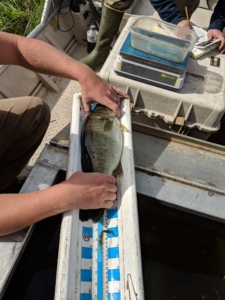
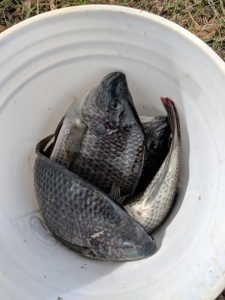
The first trip around the perimeter of the lake was discouraging. We hadn’t seen any Bass and we continually pulled up Tilapia, an Armored Catfish. The Tilapia are great for eating, but not what you want in a world class Bass lake. They are territorial, and will eat your Bass bate, and by the size of the Tilapia, they have been eating good for some time!
After the first half hour we had accumulated a fair share of fish, but no Bass. We netted Bowfin, Eel, Armored Catfish, Tilapia, Suckers, Golden Shiners, and Bluegill.
After documenting all the sizes and species from the first round, we headed back out for round two. This time was more encouraging, and a lot more exciting.
The Second Sweep Electrofishing The Lake
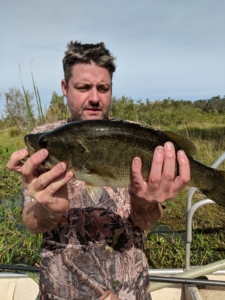
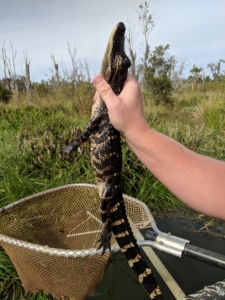
The very first catch we made was a baby Alligator! We let him go though, since Alligators are protected in Florida, and can’t be caught or killed legally by anyone not certified through the FWC (Florida Wildlife Commission).
After an hour and a half, we finally caught the fish we were waiting for! Bass! Even though we only caught one Bass, this particular Bass was a lot larger than we had expected. This Bass was almost 4 pounds!
We may have only caught one Bass, but it was exciting to see that they are in there, and they were pretty big too!
After we had electrofished everywhere we could, we headed back to shore to do one last documentation of the fish we had netted on the second round.
Finishing The Electrofishing Trip
SOLitude explained to us that we had the perfect environment for a world class bass fishing lake, but that we may need to stock the lake with more Bass. The bait is there, and the spawning areas are perfect, so our goal way not be far from reach.
A full analysis of the electrofishing trip is taken back to the SOLitude lab. They do a specimen breakdown, and water quality tests, so we know the exact condition of the lake.
In Conclusion
Overall this trip was a success. We go to see fish we couldn’t never seem to catch on a line, and have a better understanding on how we make this into a better bass fishing lake.
Just because a bunch of Bass weren’t netted, doesn’t mean they aren’t there, or that they can’t be there in the future.
The only downfall of electrofishing the lake, was that the lake is almost 14 feet deep in some locations. This makes it impossible to shock the fish anywhere beyond 5 feet deep.
I know that there are some big fish lurking in the deep, and one day I will figure out a way to catch them, and make it so anyone can catch a big fish when throwing a line into our lake.
Stay tuned for more about how the Bass fishing lake turns out and thank you so much for reading! Check back for the video that accompanied this article to watch how the electrofishing experience was conducted!






Maybe get a fish finder.
I was very surprised that the company that electrofished the lake didn’t have one! It would have helped for sure.